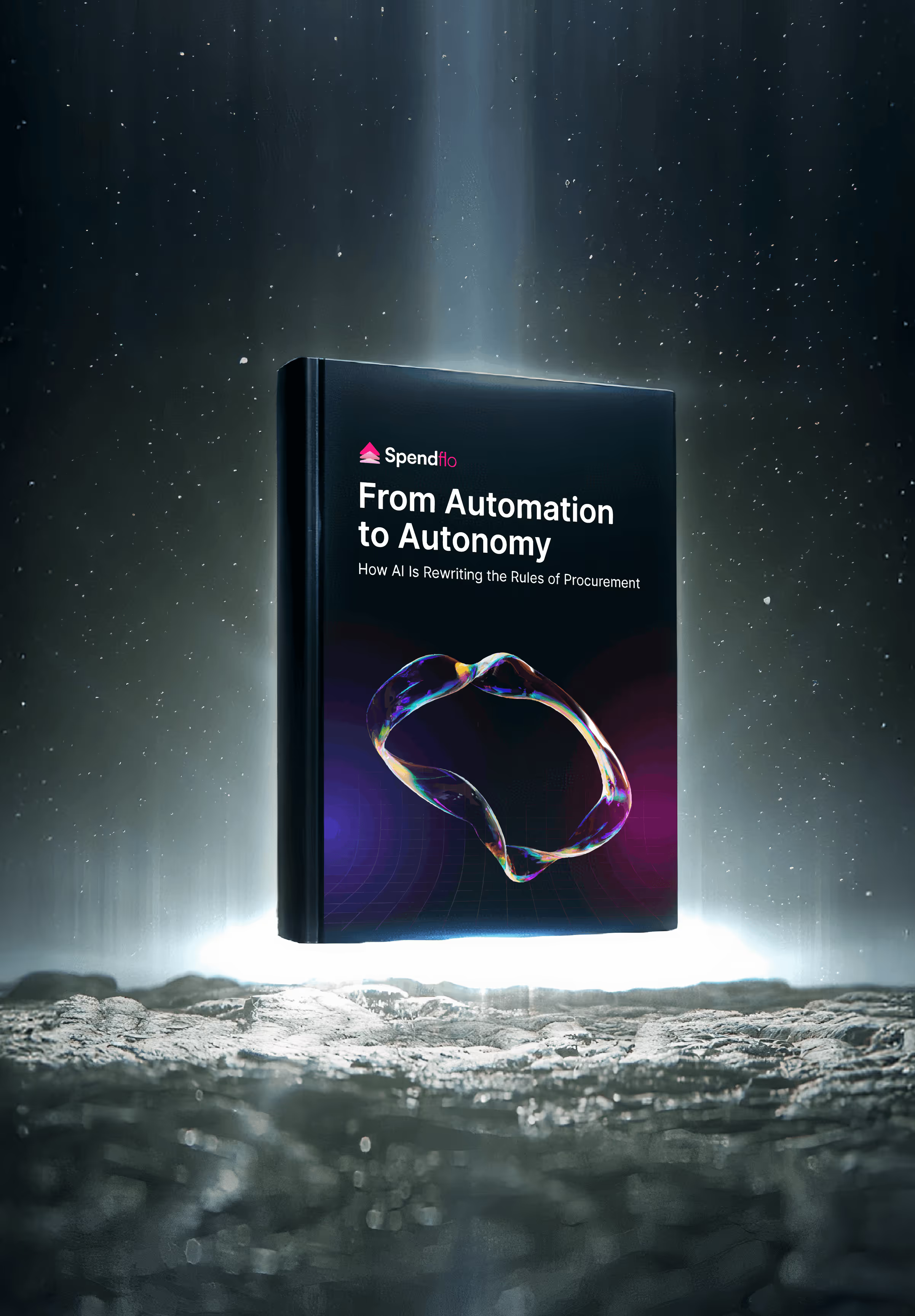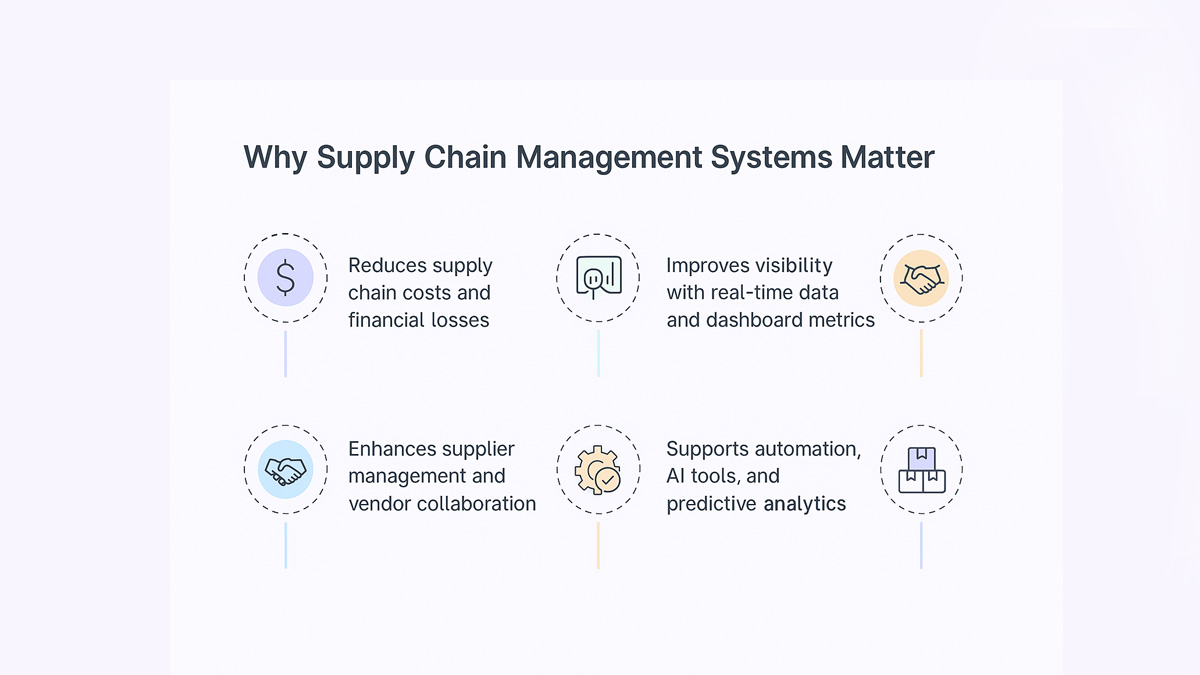

Top 10 Supply Chain Management Systems (SCM)

Top 10 Supply Chain Management Systems (SCM)
Explore the top 10 supply chain management systems that help reduce costs, improve visibility, and streamline vendor collaboration.


Think of a supply chain like a relay race. One misstep, and the baton gets dropped - delays pile up, costs skyrocket, and customer trust takes a hit. In today's fast-moving, tech-driven world, businesses can't afford those stumbles. That’s where supply chain management systems (SCM) come in.
These systems act like the pit crew in Formula 1 - keeping everything running smoothly behind the scenes. From forecasting demand and managing inventory to tracking shipments in real time, SCM platforms have become essential tools in reducing waste, controlling costs, and staying competitive.
What this blog will cover:
- What is a supply chain management system?
- Why are supply chain management systems important?
- Top 10 supply chain management systems
- How Spendflo helps optimize supplier and software management in your supply chain
- Frequently asked questions on supply chain management systems
What Is a Supply Chain Management System?
A supply chain management system is software that helps businesses plan, manage, and optimize every step in the supply chain - from sourcing raw materials to delivering finished goods. It connects processes like procurement, inventory, logistics, and supplier management into one coordinated flow, often in real time.
Why Are Supply Chain Management Systems Important
Supply chains are more fragile than ever - one unexpected delay, and the ripple effects can span continents. A late shipment in Shanghai might mean empty shelves in Chicago. That’s why having a smart, connected system in place isn’t just helpful - it’s critical.

Reduces Supply Chain Costs and Financial Losses
Inefficiencies in procurement, overstocking, and unplanned freight costs all eat into your margins. SCM systems use automation and real-time data to flag these issues early - so you can fix leaks before they drain your budget.
Improves Visibility With Real-Time Data and Dashboard Metrics
Imagine trying to steer a ship without radar. SCM systems give you that visibility - dashboards that show where your goods are, how inventory is moving, and where bottlenecks might occur. The result? Faster, smarter decisions.
Enhances Supplier Management and Vendor Collaboration
Strong supplier relationships are built on communication and accountability. These platforms enable shared visibility, automated updates, and even vendor-managed inventory - keeping both sides aligned and productive.
Supports Automation, AI Tools, and Predictive Analytics
From machine learning-powered demand forecasting to auto-replenishment triggers, today’s top systems do more than track - they think. They reduce manual work, lower error rates, and give you predictive insights that help you plan with confidence.
Boosts Inventory and Warehouse Optimization
An overstuffed warehouse ties up capital; an understocked one risks lost sales. SCM systems find the sweet spot - using data-driven insights to balance inventory, avoid stockouts, and increase productivity where it matters most.
Top 10 Supply Chain Management Systems
From global manufacturers to fast-scaling startups, businesses rely on supply chain management systems to keep operations running smoothly. But not all platforms are built the same. Some excel at logistics, others at planning or supplier collaboration. And then there are newer platforms that bring a fresh, tech-forward take to procurement and vendor management.
We’ve rounded up 10 of the most impactful SCM systems - from established giants like SAP and Oracle to modern disruptors like Spendflo. Whether you’re trying to reduce costs, improve visibility, or better manage suppliers, these tools cover a range of capabilities to suit different needs.
1. Spendflo
Spendflo is a modern SaaS procurement and supplier management platform built to give finance and procurement teams complete visibility and control over their software and vendor relationships. It combines strategic sourcing with real-time analytics to optimize cost, reduce risk, and streamline procurement cycles.
What it does best: End-to-end supplier lifecycle management with embedded negotiation services.
Ideal for: Mid-size to enterprise businesses seeking cost savings and full-stack SaaS procurement control.
Pricing: Custom pricing based on company size and procurement needs. Demo required.
Top features:
- Centralized supplier repository
- Real-time dashboards and supplier scorecards
- AI-powered risk alerts and compliance tracking
- Contract lifecycle and renewal workflows
- Automated onboarding and approval workflows
- Spend analysis and benchmarking
- Audit-ready reporting and documentation
- Integration with ERPs, Slack, and procurement tools
2. SAP SCM
SAP SCM (Supply Chain Management) is part of SAP’s broader ERP suite and is designed for end-to-end supply chain visibility and planning.
What it does best: Advanced planning, forecasting, and ERP integration.
Ideal for: Large enterprises operating global supply chains.
Pricing: Enterprise-level custom pricing.
Top features:
- Integrated demand forecasting
- Supplier collaboration hub
- Warehouse and transport management
3.Oracle SCM Cloud
Oracle SCM Cloud is a flexible, cloud-based platform that covers everything from procurement to logistics and manufacturing.
What it does best: Scalability and comprehensive SCM coverage.
Ideal for: Mid-to-large enterprises with diverse supply chain needs.
Pricing: Subscription-based, with pricing tiers depending on features.
Top features:
- Order and inventory management
- Integrated logistics
- Procurement automation
4. Blue Yonder
Blue Yonder offers AI-powered predictive supply chain planning, particularly strong in retail and logistics.
What it does best: Machine learning-driven demand forecasting.
Ideal for: Retailers and logistics-heavy operations.
Pricing: Custom pricing.
Top features:
- Predictive analytics for inventory planning
- Warehouse labor and task optimization
- Transport and route management
5. Manhattan Associates
Known for its robust warehouse and transportation solutions, Manhattan Associates delivers advanced supply chain execution tools.
What it does best: Warehouse and distribution center management.
Ideal for: Large retailers and distributors.
Pricing: Custom quote based on deployment model.
Top features:
- Warehouse management system (WMS)
- Transport management
- Labor and slotting optimization
6. Infor Supply Chain
Infor’s SCM solution blends AI, real-time data, and user-friendly interfaces across the entire supply chain.
What it does best: AI-driven insights and intuitive UI.
Ideal for: Manufacturing and healthcare supply chains.
Pricing: Tiered subscription pricing.
Top features:
- Integrated planning and execution
- Supply chain visibility tools
- Supplier collaboration platform
7. Coupa
Coupa is a business spend management platform offering powerful procurement, supply chain, and expense tracking tools.
What it does best: Unified spend visibility and control.
Ideal for: Procurement-focused finance teams.
Pricing: Subscription-based, with feature bundles.
Top features:
- Spend and supplier analytics
- Contract and invoice tracking
- Inventory control
8. Kinaxis RapidResponse
Kinaxis specializes in real-time supply chain planning and risk mitigation through its RapidResponse platform.
What it does best: Fast scenario modeling and risk control.
Ideal for: Enterprises managing dynamic, global supply chains.
Pricing: Enterprise pricing on request.
Top features:
- Concurrent planning engine
- Real-time risk simulation
- Inventory and capacity planning
9. E2open
E2open offers a connected supply chain platform focused on collaboration across global trading networks.
What it does best: Multi-enterprise collaboration.
Ideal for: Companies with complex supplier ecosystems.
Pricing: Custom quote required.
Top features:
- Global logistics tracking
- Integrated planning
- Supplier risk visibility
10. Descartes Systems Group
Descartes delivers cloud-based logistics and transportation management solutions designed for real-time delivery optimization.
What it does best: Transport and global trade compliance.
Ideal for: Logistics providers and e-commerce companies.
Pricing: Modular pricing depending on selected tools.
Top features:
- Real-time fleet tracking
- Route optimization tools
- Customs and compliance support
How to Choose the Right System?
With so many supply chain management systems on the market, it’s easy to feel overwhelmed. Each platform promises better visibility, smarter automation, and faster results - but not every tool fits every business. The right SCM solution should align with your current operations while scaling effortlessly as your needs evolve. It’s not just about flashy features - it’s about solving real problems, without creating new ones.
Before you make the leap, here are four essential factors to guide your decision.
Define Your Supply Chain Needs and Goals
Start by identifying what gaps exist in your current supply chain. Are you struggling with delayed shipments, poor inventory visibility, or disconnected vendor communications? Knowing your pain points helps you prioritize features - whether that’s demand forecasting, supplier portals, or real-time analytics. Your SCM system should be a response to your operational challenges, not just a tech upgrade.
Evaluate Integration and Compatibility With Existing Tools
You don’t want to reinvent the wheel - you want a smoother ride. Choose a system that plays nicely with your ERP, CRM, and accounting tools. Poor integration often leads to duplicate work, data silos, and costly delays. APIs, prebuilt connectors, and open architecture go a long way in making your ecosystem seamless.
Prioritize Scalability, Customization, and Ease of Use
Your business will grow. Your supply chain will get more complex. Pick a system that grows with you. Whether it’s adding new warehouse locations or onboarding more suppliers, the platform should be flexible enough to adapt - and simple enough that your team actually uses it.
Assess Vendor Support, Pricing, and Total Cost of Ownership
Flashy demos can be deceiving. Look beyond the interface - how’s the post-sale support? What’s included in the license? Ask about onboarding, customer success, training, and ongoing support. And don’t forget to factor in hidden costs like custom integrations or additional users.
How Spendflo can Help
Spendflo isn’t just another procurement tool - it’s a strategic partner for companies looking to simplify vendor management and gain total control over SaaS and supplier costs. By centralizing supplier data, automating approval workflows, and embedding expert negotiation support, Spendflo reduces overspending and eliminates renewal chaos.
With real-time dashboards, audit-ready documentation, and integrations across your procurement stack, you get more than visibility - you get leverage. Whether you're managing 20 vendors or 200, Spendflo helps you move faster, spend smarter, and stay in control.
Frequently Asked Questions on Supply Chain Management Systems
What Is the Difference Between Supply Chain Management Systems and ERP Systems?
SCM systems focus specifically on planning, managing, and optimizing the supply chain - from sourcing and procurement to logistics and delivery. ERP systems are broader, covering finance, HR, and operations too. Many companies use SCM as a specialized layer on top of their ERP.
How Do Supply Chain Management Systems Help Reduce Costs?
They identify inefficiencies before they become expensive mistakes. From optimizing inventory levels
to reducing shipping delays and automating manual tasks, SCM tools help prevent waste, avoid penalties, and improve your bottom line over time.
Which Features Should I Look for in a Good SCM Software?
That depends on your business needs - but generally, look for real-time tracking, supplier management, demand forecasting, warehouse optimization, and integration with existing systems. Bonus points for AI tools, mobile access, and customizable dashboards.
Are Cloud-Based Supply Chain Platforms Better Than On-Premise Solutions?
In most cases, yes. Cloud platforms offer better scalability, lower upfront costs, faster updates, and easier collaboration across teams. On-premise might still work for highly regulated industries - but the cloud is where the future's headed.
How Can AI and Automation Improve Supply Chain Management?
AI can forecast demand more accurately, spot risks before they escalate, and suggest smarter decisions based on historical data. Automation handles repetitive tasks - like reordering stock or updating delivery status - so your team can focus on strategy instead of firefighting.
How does invoice processing impact supply chain and demand planning?
Efficient invoice processing supports demand planning by providing real-time spend visibility, helping teams make informed inventory and procurement decisions. When integrated with supply chain management software and ERP software, it improves alignment between finance and operations especially during supply chain disruption. Faster processing also reduces delays across logistics networks, ultimately boosting customer service by ensuring products are delivered on time.
Can automation in invoice processing reduce supply chain risks?
Absolutely. Automation powered by artificial intelligence enhances risk management by flagging irregularities early and supporting accurate scenario planning. It also improves data accuracy feeding into enterprise resource planning and customer relationship management systems. By strengthening your digital supply chain and enabling proactive responses to shifting market conditions, automated invoice workflows help maintain stability and enable smarter inventory optimization.










.png)




.png)










.avif)





